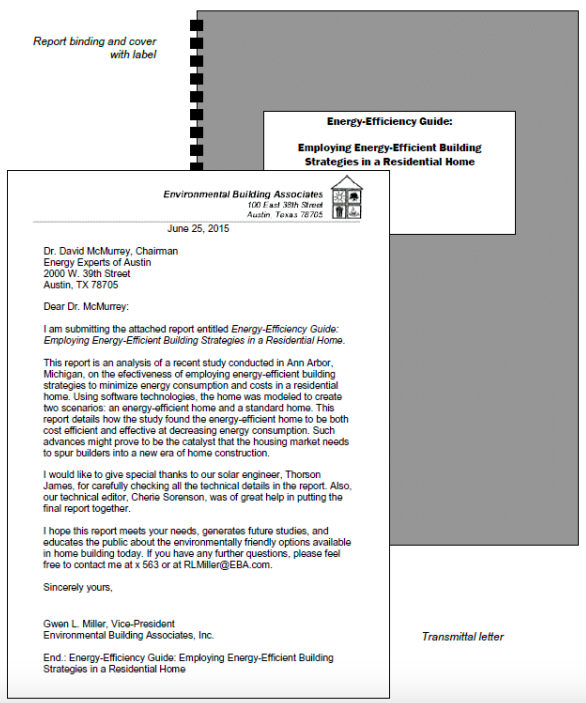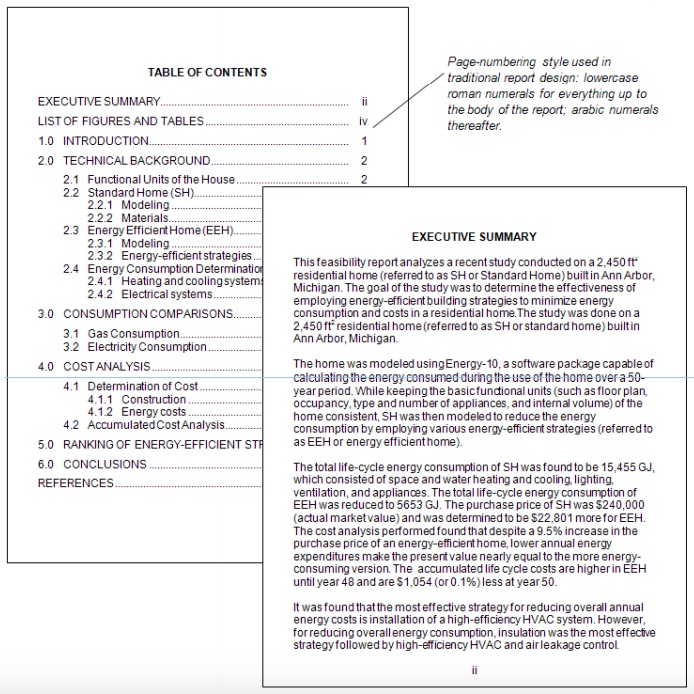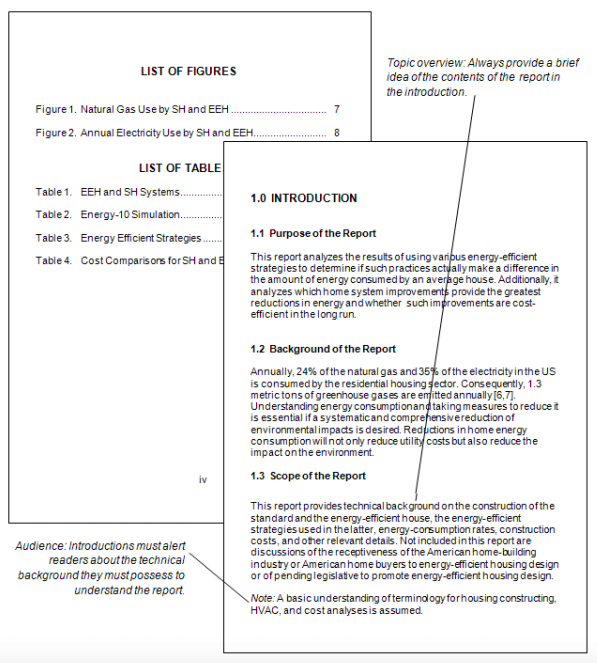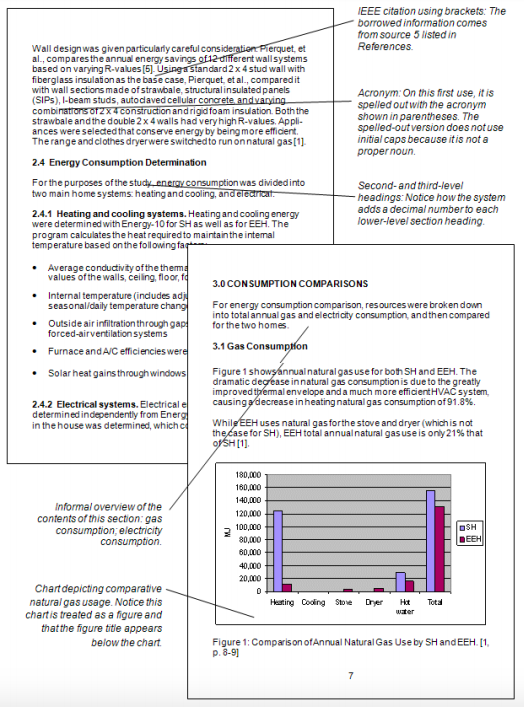4.1: Report Design
- Page ID
- 51537
Learning Objectives
Upon completion of this chapter, readers will be able to do the following:
- Explain the importance of effective report design.
- Explain the purpose of a letter of transmittal.
- Define when covers and labels are appropriate for reports.
- Explain the purposes of and write a descriptive abstract and executive summary for a report.
- Apply design principles of tables of contents and figures.
- Apply basic design considerations on the body of a report.
- Define the appropriateness of a conclusion, appendix, and information sources.
Technical reports (including handbooks and guides) have various designs depending on the industry, profession, or organization. This chapter shows you one traditional design. If you are taking a technical writing course, make sure the design presented in this chapter is acceptable. The same is true if you are writing a technical report in a science, business, or government context.
Technical reports have specifications as do any other kind of project. Specifications for reports involve layout, organization and content, format of headings and lists, the design of the graphics, and so on. The advantage of a required structure and format for reports is that you or anyone else can expect them to be designed in a familiar way—you know what to look for and where to look for it. Reports are usually read in a hurry—people are in a hurry to get to the information they need, the key facts, the conclusions, and other essentials. A standard report format is like a familiar neighborhood.
When you analyze the design of a technical report, notice how repetitive some sections are. This duplication has to do with how people read reports. They don't read reports straight through: they may start with the executive summary, skip around, and probably do not read every page. Your challenge is to design reports so that these readers encounter your key facts and conclusions, no matter how much of the report they read or in what order they read it.
The standard components of the typical technical report are discussed in this chapter. The following sections guide you through each of these components, pointing out the key features. As you read and use these guidelines, remember that these are guidelines, not commandments. Different companies, professions, and organizations have their own varied guidelines for reports—you'll need to adapt your practice to those as well as the ones presented here.
Letter of Transmittal
The transmittal letter is a cover letter. It is usually attached to the outside of the report with a paper clip, but it can be bound within the report, as a kind of author's preface. It is a communication from you—the report writer—to the recipient, the person who requested the report and who may even be paying you for your expert consultation. Essentially, it says "Okay, here's the report that we agreed I'd complete by such-and-such date. Briefly, it contains this and that, but does not cover this or that. Let me know if it meets your needs." The transmittal letter explains the context—the events that brought the report about. It contains information about the report that does not belong in the report.
Use the standard business-letter format for cover letters. If you write an internal report, use the memorandum format instead; in either case, the contents and organization are the same:
- First paragraph. Cites the name of the report, putting it in italics. It also mentions the date of the agreement to write the report.
- Middle paragraph(s). Focuses on the purpose of the report and gives a brief overview of the report's contents.
- Final paragraph. Encourages the reader to get in touch if there are questions, comments, or concerns. It closes with a gesture of good will, expressing hope that the reader finds the report satisfactory.
As with any other element in a report, you may have to modify the contents of this letter (or memo) for specific situations. For example, you might want to add a paragraph that lists questions you'd like readers to consider as they review the report.
Cover and Label
If your report is over ten pages, bind it in some way and create a label for the cover.
Covers
Covers give reports a solid, professional look as well as protection. You can choose from many types of covers. Keep these tips in mind:
- The best covers use either a spiral (best) or plastic "comb" (second-best) binding and thick, card-stock paper for the covers. These bindings allow reports to lie open by themselves, are inexpensive, and add to the professionalism of your work. Any copy shop can make one for you.
- Three-ring binders (also called loose-leaf notebooks) are a decent second choice. They allow your report to lie flat, but they are often too bulky for short reports, and the page holes tend to tear. However, if the audience will want to remove or replace pages, then a three-ring binder is an appropriate choice.
- Three-hole binders that use brads to hold the pages together are a distant third choice. They are less bulky than three-ring binders, but they prevent the pages from lying flat, and readers must either weigh down or crease the pages. If you do use one of these, add an extra half-inch to the left margin to account for the "gutter" between pages.
- Clear (or colored) plastic slip cases with the plastic sleeve on the left edge are never appropriate for a professional report. These are like something out of grade school, and they are aggravating to use. They won't lay flat, so readers must struggle to keep them open, and they generate static electricity, which makes pages stick together.
Labels
Be sure to devise a label for the cover of your report. It's a step that some report writers forget. Without a label, a report is anonymous; it gets ignored.
The best way to create a label is to use your word-processing software to design one on a standard page with a graphic box around the label information. Print it out, then go to a copy shop and have it photocopied directly onto the report cover.
There are no standard requirements for the label, although your company or organization should have its own requirements. Common elements to include are
- the report's formal title
- the intended recipient
- the authors (or, often, the author's organization)
- a report tracking number
- the date of submission

Figure \(\PageIndex{1}\)
Abstract and Executive Summary
Most technical reports contain a descriptive abstract or an executive summary, and sometimes both. Each element summarizes a report's contents, but they do so in different ways and for different purposes.
Descriptive Abstract
This brief paragraph provides a capsule overview of the report's purpose and contents. It's usually a single paragraph. In many report designs, the descriptive abstract appears at the bottom of the title page (not the cover page), as shown in the following example.
Example
LIGHT WATER NUCLEAR REACTORS
submitted to
Mr. David A. McMurrey
Energy Research Consultants, Inc.
Austin, Texas
April 27, 19XX
by Jeffrey D. Lacruz
This report examines light water reactors as a possible alternative source of energy for Luckenbach, Texas. Both types of light water reactors are described, and an explanation of how each reactor produces electricity is presented. Safety systems and economic aspects conclude the main discussion of the report.
Descriptive abstract
Executive Summary
Another common element in a report's front matter is an executive summary, which also summarizes the key facts and conclusions contained in the report. Its purpose is to allow a busy executive to absorb the report's major findings without having to wade through pages of details. A typical executive summary runs from a half-page to two pages, but it can be longer if the report is very long.
Table of Contents and Table of Figures
Table of Contents
Any technical document of more than a few pages that includes distinct major sections should include a table of contents (ToC), and each major section should start on a new page.
The ToC should not include the title page or the cover letter/memo. If the proposal includes an abstract and/or executive summary, those sections should appear in the ToC, and it is customary to paginate them with lower-case roman numerals. The ToC should not include itself. Treat it as page zero.
Always include at least the top two levels of headings, but how many subheading levels you include in a ToC is up to you. A long, complex report with multiple subheadings may need a ToC entry for each subheading, but this approach may result in an extremely long and confusing ToC. A potential solution is to create two ToCs, one listing just the top two levels of headings and one listing all levels of headings.
One final note: Make sure the words in the ToC are the same as they are in the text. As you write and revise, you might change some of the headings—don't forget to update the ToC accordingly. See Figure 3 for an example of a ToC and executive summary:

Figure \(\PageIndex{2}\)
Downloadable example of executive summary
Table of Figures
The table of figures (ToF), sometimes called the "list of figures," has many of the same design considerations as the table of contents. Readers use the ToF to find the illustrations, diagrams, tables, and charts in your report.
Please note that tables and figures are different things. Strictly speaking, figures are illustrations, drawings, photographs, graphs, and charts. Tables are rows and columns of words and numbers; they are not considered figures.
For longer reports that contain multiple figures and tables, create separate lists of figures and tables. Put them on a separate page from the ToC, but put them together on the same page if they fit. You can identify the lists separately, as Table of Figures and Table of Tables.
Introduction
In a technical report, the introduction prepares the reader to read the main body of the report. It introduces the report's purpose, specifies the report's intended audience, provides a limited description of the report's context and background, forecasts the report's scope, and previews the report's contents and/or organization.

Figure \(\PageIndex{3}\)
Downloadable example of introduction
If the introduction, executive summary, and letter of transmittal strike you as repetitive, remember that readers don't necessarily start at the beginning of a report and read page by page to the end. They skip around: they may scan the table of contents; they usually skim the executive summary for key facts and conclusions. They may read carefully only a section or two from the body of the report, and then skip the rest. For these reasons, reports are designed with massive duplication so that readers will be sure to see the important information no matter where they dip into the report.
Major Design Considerations
This part of the chapter describes several design-related issues that you will likely need to consider when creating a report.
Headings. In all but the shortest reports (two pages or less), use headings to mark off the different topics and subtopics covered. Headings enable readers to skim your report and dip down at those points where you present information that they want.
Bulleted and numbered lists. In the body of a report, also use bulleted, numbered, and two-column lists where appropriate. Lists help by emphasizing key points, by making information easier to follow, and by breaking up solid walls of text.
Symbols, numbers, and abbreviations. Technical discussions ordinarily contain lots of symbols, numbers, and abbreviations. Remember that the rules for using numerals as opposed to words are different in the technical world. The old rule of thumb about writing out all numbers below 10 does not always apply in technical reports.
Graphics and figure titles. In a technical report, you're likely to need drawings, diagrams, tables, and charts. These not only convey certain kinds of information more efficiently but also give your report an added look of professionalism and authority. If you've never put these kinds of graphics into a report, there are some relatively easy ways to do so—you don't need to be a professional graphic artist.

Figure \(\PageIndex{4}\)
Cross-references. You may need to point readers to closely related information within your report, or to other books and reports that have useful information. These are called cross-references. For example, you can point readers from the discussion of a mechanism to an illustration of it. You can point readers to an appendix where background on a topic appears (background that just does not fit in the text). And you can point readers outside your report to other information— to articles, reports, and books that contain information related to yours.
Page numbering. All pages in the report (excluding the front and back covers, title page, and ToC) are numbered. Use lower-case roman numerals to paginate material that appears before the ToC. Don't number the ToC; it's page zero. Use arabic numerals to paginate material that appears after the ToC.
Longer reports often use the page-numbering style known as folio-by-chapter or double-enumeration (for example, pages in Chapter 2 would be numbered 2-1, 2-2, 2-3, and so on, and pages in Appendix B would be numbered B-1, B-2, and so on). Similarly, tables and figures would use this numbering style. This style eases the process of adding and deleting pages.
If page numbers appear in a running header, don't display numbers on pages where a heading or title is at the top of the page (such as chapter or section openers).
Conclusions
For most reports, you'll need to include a final section in which you sum up the report's contents and provide a "takeaway" for the reader. When you plan this final section of your report, think about the functions it can perform in relation to the rest of the report.
Appendices
An appendix is an "extra" section that appears after the proposal's main body. Any useful content that you feel is too large for the main part of the proposal or that you think would be distracting and interrupt the flow of the proposal should go into an appendix. Common examples of appendix-appropriate material are large tables of data, big chunks of sample code, fold-out maps, background that is too basic or too advanced for the body of the report, or large illustrations that just do not fit in the main body.
Use separate appendices for each item or category of items, and label each one alphabetically, as "Appendix A: (descriptive title of contents)" and so on. If you've got only one appendix, continue the proposal's page numbering scheme. If you have multiple appendices, you can number each appendix's pages separately, as A-1, A-2, and so on.
Information Sources
If your proposal quotes, paraphrases, or summarizes information that came from outside sources, cite the sources appropriately in the main text and include bibliographic information in a separate section at the proposal's end. Use whatever citation format is appropriate for your audience's profession and field. Common formats include IEEE, MLA, APA, CSE, Chicago, and Turabian.


